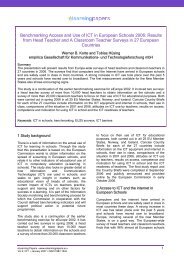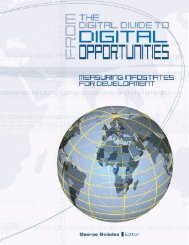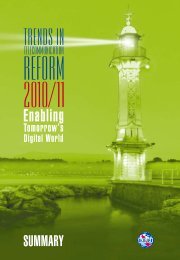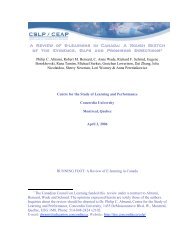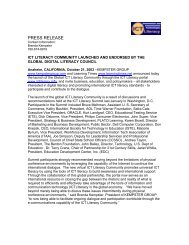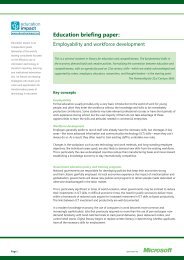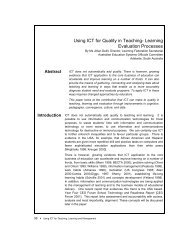147 pages pdf - ICT Digital Literacy
147 pages pdf - ICT Digital Literacy
147 pages pdf - ICT Digital Literacy
You also want an ePaper? Increase the reach of your titles
YUMPU automatically turns print PDFs into web optimized ePapers that Google loves.
Content, Content (Not To Mention Content) … How To Best Design & Deliver It<br />
#288: Save Learner Time, Build In Help<br />
Build in a help system to allow the user to determine how the course works.<br />
Roger Steinhorst<br />
Fireman's Fund Insurance Companies<br />
#289: Huh? Where Was That Covered?<br />
Make objectives of what you want to accomplish with the e-Learning. Make sure all training activities and<br />
test questions match the objectives. Next make sure the test questions are answerable based on the<br />
information presented in the e-Learning material. There is nothing more frustrating to a learner than being<br />
expected to pass an evaluation test based on presumed knowledge.<br />
Michael Tucker<br />
Compuware Corporation<br />
#290: Can You Hear Me Now?<br />
E-Learning should have voice recognition so when a student has to reply, he/she can do so with<br />
normal discussion/feedback/brainstorming/idea generation -- as if replying face-to-face to a<br />
teacher. Words can be automatically typed as he/she speaks so the train of thought is not lost -<br />
- then edited afterwards. This is especially effective if an individual cannot type fast enough.<br />
Dori Ottaviano<br />
#291: Practice "Hidden" Instructional Design<br />
Most heuristics in instructional design -- such as objectives and sequencing -- is for the<br />
instructional designer to better understand the task at hand and NOT for the learners. All the<br />
learners need is a seamless, meaningful and memorable experience.<br />
Maish Nichani<br />
eLearning Post<br />
#292: "Elastic" Design<br />
When designing e-Learning, the "one size fits all" philosophy will not work. With the multitude of<br />
technologies out there, don't try to create THE BEST way to get your message out, instead<br />
create ANOTHER ALTERNATIVE to getting a message out.<br />
Brian Lauer<br />
Freddie Mac<br />
#293: Use Standard Default Fonts When Publishing<br />
Despite the thousands of fonts that are available only a few have become regarded as<br />
standards for the Internet. A browser will select a font from the viewer’s computer to create the<br />
content. Although a content developer may select one font, the viewer’s browser will select<br />
another is the original font isn’t available. This system has evolved so that now a handful of<br />
fonts are default fonts. They are: Arial, Arial Black, Times, Comic Sans, Courier, Courier New,<br />
Georgia, Helvetica, Times New Roman, Times, Trebuchet, and Verdana. If you specify these<br />
fonts for live text, your viewer will likely view them as you designed them. For other fonts, you<br />
should convert your text to a graphic in a program like Photoshop or Illustrator. If you specify a<br />
non-standard font, the browser will convert it to a default font. To insure your communications<br />
arrive as planned, stick to the short list<br />
Jeff Harris<br />
Trivantis Corporation<br />
#294: Don't Overwhelm Your SME<br />
SMEs hate to review storyboards. Find ways to make it as easy for them as possible by using<br />
visuals and avoiding unnecessary details (file names, notes to programmers, etc.).<br />
Deborah E. Blank, Ph.D.<br />
SI International<br />
701 e-Learning Tips by The MASIE Center www.masie.com 58



